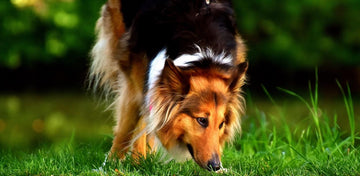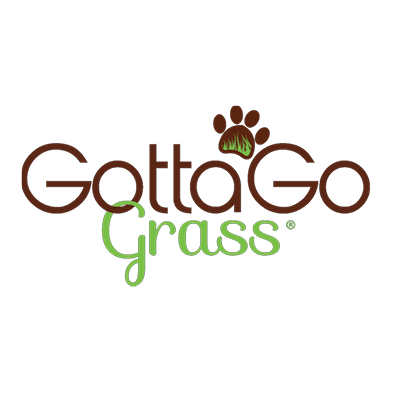
You know that moment—you open the door, and your dog trots out, nose glued to the ground, circling and sniffing with great intent before finally picking the perfect potty spot. It may seem random to us, but to dogs, this ritual is a deeply instinctual process powered by one of their strongest senses: smell.
For dogs, scent is more than just a way to identify food or detect danger—it’s their way of understanding the world. They perceive life through their noses, analyzing invisible layers of scent to gather information about territory and other animals. It’s why they don’t just choose any patch of grass—they choose the right one.
Yet, when dogs are moved indoors or to small spaces, many pet owners unknowingly take away the very thing dogs rely on most: scent. Artificial potty solutions, such as synthetic grass or disposable pee pads, often smell nothing like the outdoors. As a result, many dogs struggle with potty training or refuse to go at all. Understanding your dog’s instincts—and providing options that honor them—can make all the difference.
How Dogs Choose Their Potty Spot
It’s incredible how a dog’s sense of smell really is. Compared to humans, dogs have over 100 million sensory receptor sites in their nasal cavity—we have only about six million—and the part of their brain that processes scent is roughly 40 times larger. In simple terms, your dog’s nose is their superpower.
When a dog chooses where to go, they’re not thinking about convenience—they’re reading scent cues. Dogs identify cleanliness, familiarity, and territory through their sense of smell. They can tell if another dog has used the spot before, whether it’s been recently cleaned, or even if the area feels “safe.” These scent markers, including pheromones and the natural aroma of grass, tell your dog, “This is the right place.”
Real grass has a unique scent signature that synthetic materials can’t replicate. It signals freshness, nature, and comfort—exactly what a dog’s instincts are wired to seek. On the other hand, plastic or artificial pads can smell foreign, sterile, or even unpleasant, confusing your dog’s natural potty-seeking behavior.
It’s why, in terms of potty training, scent isn’t just important—it’s everything.

The Natural Advantage: Why Real Grass Pads Work Best
Enter Gotta Go Grass, a dog grass pad with a tray made from real, living grass. Unlike synthetic or single-use potty solutions, it offers the same earthy scent, cool texture, and organic feel your dog instinctively recognizes. For pups who live in apartments or homes without easy outdoor access, this setup provides a familiar, natural space to do their business—right indoors.
Natural grass pads recreate the environment dogs are naturally drawn to. The feel under their paws, the cool moisture, and the familiar scent immediately communicate “this is where I go.” It means less hesitation, faster potty training, and fewer accidents inside your home.
For puppies, this natural familiarity makes housebreaking much easier. Instead of confusing your pup with fake grass or paper pads that don’t smell like anything they know, you’re giving them a sensory cue they already understand. Training older dogs to transition from outdoor potty routines is also more seamless—they don’t need to relearn where to go, just adjust to the new location.
Convenience is another major plus. With Gotta Go Grass, there are no synthetic odors, and cleanup is simple. The grass absorbs liquids naturally, and the built-in tray prevents seepage, keeping your floors dry and tidy. When the grass starts to wear out, simply replace the patch with a fresh one—no scrubbing or heavy sanitizing required.
Best of all, because it’s real grass, your home stays fresher too. No lingering smells, just the light, natural scent of greenery. It’s an eco-friendly, instinct-friendly solution both pets and humans can appreciate.
The Problem with Common Alternatives
Of course, real grass pads aren’t the only potty solution out there—but most alternatives miss the mark when it comes to honoring a dog’s instincts.
Synthetic grass pads, for example, are often marketed as long-lasting or easy to clean. While they may seem convenient, they can make potty training harder. Dogs pick up on the plastic smell and quickly realize it’s not grass. Instead of encouraging your pup to “go,” it can confuse or even deter them. Plus, these pads often trap odors rather than neutralizing them, making them smell worse over time.
Then there are disposable pee pads—the single-use kind that looks like giant paper towels. They’re highly absorbent but completely lack the natural scent cues dogs depend on. Many even come with artificial attractant sprays designed to mimic pheromones or grass odor, but these can overwhelm sensitive noses and, in some cases, contain chemicals that aren’t pet-safe. The sterile smell might appeal to us, but for dogs, it’s far from inviting.
And beyond instinct, there’s the environmental cost. Single-use pads generate a ton of waste, contributing to landfill buildup. They may seem handy for short-term training, but over time, they’re costly, wasteful, and anything but sustainable.
In contrast, a natural grass pad like Gotta Go Grass respects both your dog’s nose and the planet. It provides a familiar, comfortable potty surface while reducing plastic waste and chemical exposure.
A More Natural Routine: Beyond the Grass Pad
A truly dog-friendly potty routine goes beyond where your pet goes—it’s also about keeping that space clean and inviting. Dogs are naturally sensitive to scent, so maintaining a sanitary potty area encourages them to keep using it. Just as you’d pick up after your dog during walks, cleaning up promptly at home helps reinforce the idea that their grass pad is a consistent, comfortable place to go.
For both indoor and outdoor cleanups, having a dog poop bag holder clipped to your leash or kept near the pad makes things effortless. You’ll always have dog waste bags ready when your pup finishes, keeping their potty area fresh, odor-free, and ready for the next use for longer.

Training Tips: Helping Your Dog Recognize the Spot
Whether you’re introducing a puppy to their first potty pad or helping an older dog adjust to indoor living, a little guidance goes a long way.
First, place the grass pad where your dog already tends to go—close enough to be convenient but away from food and bedding—and build a simple routine around it.
Lead them to the pad after meals, naps, or play; use the same verbal cue each time; and let the real-grass scent do much of the work. If needed, reinforce the smell with a small dab from a previous outdoor spot.
Keep the area tidy by removing solids promptly and rinsing the tray, but avoid over-sanitizing—dogs respond better to a faint trace of their own scent than to a sterile surface.
Above all, be patient and positive: praise or a small treat for successes, gentle redirection for mistakes, and consistent repetition will have most dogs using the pad reliably.
For a full, step-by-step program—including setup, daily schedule, scent-transfer tricks, troubleshooting for accidents or marking, and tips for both puppies and older dogs—see the article How to Train Your Dog to Use Gotta Go Grass® Potty Pads.
Final Thoughts – Let Nature Lead the Way
When it comes to potty training, scent isn’t just a detail—it’s the foundation. Dogs rely on their noses to navigate the world, communicate, and make choices. Ignoring that instinct often leads to confusion and frustration, both for pets and their owners.
By choosing natural solutions like Gotta Go Grass, you’re not just providing convenience—you’re respecting your dog’s instincts. And that makes training smoother, cleaner, and more stress-free for everyone involved.
So let nature do what it does best. Give your pup a familiar, inviting potty experience—complete with the sights, textures, and scents they trust most.
And when you’re ready to build your dog’s full setup, explore Gotta Go Grass for more than just grass pads. You’ll find handy accessories like dog waste bag dispensers, waste bags, and even squeaky toys for rewarding good behavior.
Because when you honor your dog’s instincts, every part of their routine—potty breaks included—feels a little more natural.




